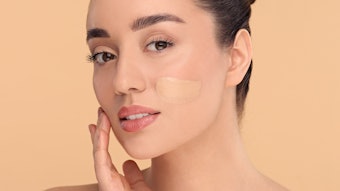At In-Cosmetics in Milan, Greentech launched a new anti-aging active designed to smooth skin and reduce the appearance of fine lines and wrinkles. Setiline (INCI: Hydrolyzed Trigonella Foenum-Graecum (Fenugreek) Seed Extract) reportedly acts simultaneously against glycation in the dermis and keratinization in the epidermis. These actions allow it to maintain suppleness, firmness and elasticity to skin.
Nearly 45% of fenugreek seeds are comprised of the polysaccharide galactomannan. The company therefore developed a process to source the oligogalactomannanes from fenugreek. The resulting active is said to prevent glycation on collagen and integrin to maintain cutaneous flexibility and elasticity. Also, the active reportedly reduces keratinocyte differentiation of the epidermis to improve cutaneous barriers. As a result of the above two actions, the structure of the skin is preserved and elasticity and firmness are enhanced, improving the appearance of wrinkles.
The company conducted a transcriptomic study using DNA microarray analysis and found that the active modifies the expression of the genes involved in the skin mechanisms of glucose release (ISM1 and HK3), reactive oxygen species protection (SOD2), extracellular matric metabolism (SAA1 and MAL), and the hyperkeritinization process (KRT16). Consequently, in vitro and in vivo analyses were implemented on glycation phenomenon and keratinocyte differentiation to study the integrity of the extracellular matrix and the cutaneous structures and functions.
In an in vitro anti-glycation study, cells were treated with either 0.25%, 0.5% or 1% of the active, aminoguanidin, or a control and incubated with 200 mM of glucose (14C) for 7 days. The company reported that the active significantly decreased the level of (14C)-glucose and the level of [14C]-advanced glycation end-products (AGE), respectively by 13%, 20% and 26%. By reducing the level AGE, the active prevents glycation mechanisms in the extracellular matrix to improve cutaneous flexibility and elasticity.
The company also conducted in vitro tests on keratinocyte differentiation to report that at 1%, the active increased the involucrin amount. The involucrin is a particular marker for suprabasal skin layers and is involved into reinforcement of cutaneous structures. Consequently, skin elasticity is enhanced and dehydration limited. The active at 1% also decreased the filaggrins content. As this protein is a marker for upper layers of skin for differentiated keratinocytes, its reduction demonstrates that the cellular differentiation and desquamation are lessened in reconstructed epidermis.
An in vivo study with clinical evaluation after use of 1% active for 28 days showed that the active preserves the skin biomechanical properties firmness, elasticity, flexibility and smoothness. A sensory test with application of 1% active for 28 days found a positive effect of the active regarding its global properties in a cream and also the specific cutaneous characteristics implicated into aging mechanisms.
The active is recommended at 1–5% in: anti-aging products; regenerative facial care; anti-stretch marks care; anti-acne acne skin care; moisturizing skin care; sensitive, reactive and atopic skin care; and after sun care. According to the company, the active should be added at the end of preparation at 35–40°C for emulsions, while cooling.










